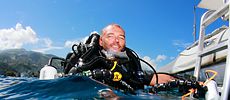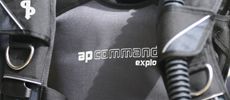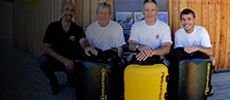This information is needed because a number of divers use Spherasorb in their AP units.
AP recommend that divers should use Sofnolime 797 in their unit – the AP units are designed and tested using this sorb. However, there are times when divers will use an alternative sorb due to cost, availability and / or because of perceived advantages in work of breathing or endurance.
Just under a year ago, in July 2015, Martin Parker of AP Diving issued a warning on the Inspiration Owners list, about the use of alternative (non-manufacturer recommended) CO2 absorbents.
“We have all used other limes, particularly when we travel but you MUST reduce your usage times compared to 797. In some cases, it should be reduced to less than 1/3rd of the 797 time!” – Martin Parker
Now new research regarding CO2 absorption has been published in the South Pacific Medicine Underwater Society (SPUMS) and the European Underwater and Baromedical Society (EUBS) journal.
Thanks to the intervention of Associate Professor Simon J Mitchell, the recreational, technical and rebreather diving communities have free, immediate access to this key safety information! (Normally the community has to wait for one – two years before they can gain access to the paper).
The paper is entitled ‘The duration of two carbon dioxide absorbents in a closed-circuit rebreather diving system’ and is published in the current edition of the quarterly publication – ‘Diving and Hyperbaric Medicine’ (Volume 45 No. 2 June 2016).
The research was conducted in the Exercise Physiology Laboratory at the Auckland University and funded by Shearwater Research.
The team included Dr. Simon Mitchell (Head of Anaesthesiology, School of Medicine, Auckland University), Dr. Nick Gant (Head of the Exercise Laboratory where the work took place) and Dr. Neal W Pollock (Research Associate, Center for Hyperbaric Medicine and Environmental Physiology, Duke University).
Test protocol
Before the research could commence the team needed to establish a test protocol that simulated moderate sustainable exertion whilst diving on a rebreather. Therefore the inhalation / exhalation hoses on an AP rebreather were modified to (a) make them longer and (b) incorporate instruments so that continuous measurement of all gases at the mouth could be recorded.
The scrubber was packed with Sofnolime 797 under the supervision of AP Inspiration rebreather instructor trainer, Pete Mesley. And indeed Mesley supervised the packing of all 10 scrubbers in this trial.
Simon Mitchell then breathed on this unit whilst exercising on a lab bike with precise resistance control allowing the team to set his exercise level at 6 METS. (The ‘metabolic equivalent’ of this would be a modest hike in hilly country).
6 METS is a level of sustained exercise that is considered plausible in diving scenarios. The oxygen consumption, CO2 production, breathing rate and breath size parameters he generated in this scenario were then adopted for all the experiments in which the rebreather was operated on the breathing machine.
Once the respiration baseline was established the research was started. An Inspiration Evo+ rebreather was artificially breathed at 6 METS using a mechanical ventilator. The inhaled CO2 was measured constantly to detect any breakthrough from the scrubber. Each “dive” was completed when the technicians observed carbon dioxide breakthrough ‘of a level that would be dangerous if it occurred in the water’. This was one kilopascal (kPa).
Ten trials were conducted in all. Five ‘dives’ with Spherasorb and five ‘dives’ on Sofnolime 797.
Results
The trials clearly demonstrated that when Spherasorb was used, the CO2 breakthrough happened on average at 137 minutes (2 hours 17 minutes). The CO2 breakthrough on the Sofnolime 797 sorb was just over an hour later, on average at 202 minutes (3 hours 22 minutes).
The team suggested that “the use of as Spherasorb is probably associated with a lower work of breathing compared to the finer grain Sofnolime material”. This “may be an advantage in certain circumstances”, ie. this sorb is specifically designed to be used in the medical field in anaesthetic machines (as opposed to diving) where CO2 production is usually much lower than that in a diving environment.
Take-home Message
In summary, rebreather divers need to check and understand what sorb you are diving. You cannot expect different kinds of sorb materials to have the same CO2 absorbing performances. You should also remember that all sorb preparations are less efficient when conditions are cold. If this is not understood and applied, it can (and may have had) fatal consequences.
The team is now expanding their sorb studies. They will be revealing the performance of solid sorb versus granular sorb, evaluation of storage strategies for partly used scrubber canisters, and an evaluation of the accuracy of temp sticks in predicting CO2 breakthrough at the European advanced diving conference – EUROTEK – on the 8th and 9th October in Birmingham, England.
Originally published June 2016 by Rosemary Lunn in X-Ray Magazine









Short answer: Yes, there is a difference in the performance, the Sofnolime performs better.
Long answer: Quoted scrubber durations are based on the use of Sofnolime 797, breathing rates of 40RMV, water temperature 4C, and proven on dive profiles to 40m and 100m. When you vary any of those parameters you are entering the land of guesswork, so you can either stick to the quoted durations or “push your luck”. Luckily we have a Scrubber Usage indicator, the Tempstik, the use of which gives us the greatest gain in real life usage. The Tempstik gives you credit for a lower work rate and/or being in warmer water and also automatically and continuously compensates for variations in depth too, giving most divers MUCH longer than the quoted durations. The rub is, the AP Tempstik is only calibrated to work with Sofnolime 797. Tests have shown us it just doesn’t work properly with other sodalimes, the warnings come in too late. On top of the fact that other similar grain sized sodalimes aren’t compatible with the Tempstik, they don’t last as long either, so you’re back to “pushing your luck”. If that’s the way you want to go, protect yourself and fit a CO2 sensor. At least that will tell when you when you need to bail out, before the symptoms get too high so you can’t bail out.
I think what I’m reading is that sorb of a larger mesh size will provide lower WOB but also shorter effective duration, which of course is what one would expect. Good to confirm it tho. The *real* question is this: is there any difference between the performance of different brands of sorb that have identical shapes and mesh sizes (eg: Sofnolime vs Intersorb)?
Interesting and informative ….confiming what we all thought me thinks !!